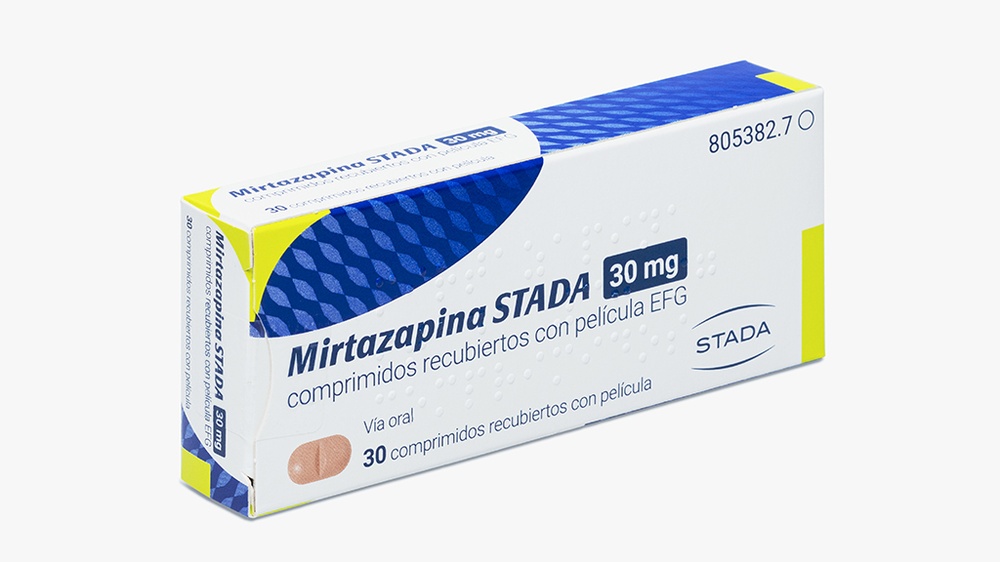

MIRTAZAPINA STADA 30 mg COMPRIMIDOS REVESTIDOS POR PELÍCULA

Pergunte a um médico sobre a prescrição de MIRTAZAPINA STADA 30 mg COMPRIMIDOS REVESTIDOS POR PELÍCULA

Como usar MIRTAZAPINA STADA 30 mg COMPRIMIDOS REVESTIDOS POR PELÍCULA
Introdução
 Prospecto: Informação para o utilizador
Prospecto: Informação para o utilizador
Mirtazapina STADA 30 mg comprimidos revestidos com película EFG
Leia todo o prospecto atentamente antes de começar a tomar este medicamento, porque contém informações importantes para si.
- Conserva este prospecto, porque pode ter que voltar a lê-lo.
- Se tiver alguma dúvida, consulte o seu médico ou farmacêutico.
- Este medicamento foi prescrito apenas para si, e não deve dá-lo a outras pessoas, mesmo que tenham os mesmos sintomas que si, porque pode prejudicá-las.
- Se experimentar efeitos adversos, consulte o seu médico ou farmacêutico, mesmo que se trate de efeitos adversos que não aparecem neste prospecto. Ver seção 4.
Conteúdo do prospecto
- O que é Mirtazapina STADA e para que é utilizado
- O que necessita saber antes de começar a tomar Mirtazapina STADA
- Como tomar Mirtazapina STADA
- Posíveis efeitos adversos
- Conservação de Mirtazapina STADA
- Conteúdo do envase e informação adicional
1. O que é Mirtazapina STADA e para que é utilizado
Mirtazapina STADA pertence ao grupo de medicamentos chamados antidepressivos.
Mirtazapina STADA é utilizado para tratar a depressão.
2. O que necessita saber antes de começar a tomar Mirtazapina STADA
NÃO tome Mirtazapina STADA
- se é alérgico a mirtazapina ou a qualquer um dos outros componentes deste medicamento (incluídos na seção 6). Nesse caso, consulte o seu médico o mais breve possível antes de tomar Mirtazapina STADA.
- se está tomando ou tomou recentemente (nas duas últimas semanas) medicamentos chamados inibidores da monoamino oxidase (IMAO).
NÃO TOMAR - OU - CONSULTE O SEU MÉDICO ANTES DE COMEÇAR A TOMAR MIRTAZAPINA:
- Se já sofreu alguma vez uma erupção cutânea intensa ou descamação da pele, ampolas ou feridas na boca após tomar mirtazapina ou outros medicamentos.
Advertências e precauções
Consulte o seu médico ou farmacêutico antes de começar a tomar Mirtazapina STADA.
Crianças e adolescentes.
Mirtazapina STADA não deve ser utilizado normalmente no tratamento de crianças e adolescentes menores de 18 anos, pois não se demonstrou a sua eficácia. Além disso, deve saber que em pacientes menores de 18 anos existe um maior risco de efeitos adversos, como tentativas de suicídio, ideia suicida e hostilidade (predominantemente agressividade, comportamento de confronto e irritabilidade) quando tomam esta classe de medicamentos. Apesar disso, o médico pode prescrever Mirtazapina STADA a pacientes menores de 18 anos quando decidir que é o mais conveniente para o paciente. Se o médico prescreveu Mirtazapina STADA a um paciente menor de 18 anos e deseja discutir esta decisão, por favor, volte ao seu médico. Deve informar o seu médico se aparecerem ou piorarem alguns dos sintomas que se detalham anteriormente em pacientes menores de 18 anos que estão tomando Mirtazapina STADA. Além disso, ainda não se conhecem os efeitos sobre a segurança a longo prazo relacionados com o crescimento, a maturidade e o desenvolvimento do conhecimento e do comportamento de Mirtazapina STADA neste grupo de idade. Além disso, foram observados aumentos de peso significativos com mais frequência em pacientes desta categoria de idade tratados com Mirtazapina STADA em comparação com os adultos tratados.
Ideias de suicídio e piora da depressão
Se se encontra deprimido, pode que às vezes tenha ideias de se fazer mal a si mesmo ou de suicídio. Isso poderia piorar quando começa a tomar os antidepressivos pela primeira vez, pois estes medicamentos  demoram em fazer efeito normalmente duas semanas ou às vezes mais. Poderia ser mais propenso a pensar desta forma se:
demoram em fazer efeito normalmente duas semanas ou às vezes mais. Poderia ser mais propenso a pensar desta forma se:
- se previamente teve pensamentos suicidas ou de se fazer mal a si mesmo.
- se é um adulto jovem. A informação dos ensaios clínicos mostrou um risco aumentado de comportamento suicida em adultos menores de 25 anos com transtornos psiquiátricos e que estavam em tratamento com um antidepressivo.
Se tiver pensamentos de se fazer mal a si mesmo ou suicídio em algum momento, consulte o seu médico ou vá a um hospital imediatamente.
Pode ser útil dizer a um parente ou amigo próximoque se encontra deprimido, e pedir-lhe que leia este prospecto. Pode pedir-lhe que lhe diga se acredita que a sua depressão está piorando, ou se está preocupado com mudanças no seu comportamento.
Assim como, tenha especial cuidado com Mirtazapina STADA
- se tem ou teve alguma vez um dos seguintes transtornos
Informa ao seu médico sobre estas situações antes de tomar Mirtazapina STADA, se não o fez ainda.
- convulsões(epilepsia). Se aparecerem convulsões ou as suas convulsões são mais frequentes, deixe de tomar Mirtazapina STADA e contacte com o seu médico imediatamente;
- doenças do fígado, incluindo icterícia. Se aparecer icterícia, deixe de tomar Mirtazapina STADA e contacte com o seu médico imediatamente;
- doenças dos rins;
- doença do coraçãoou pressão arterial baixa;
- esquizofrenia. Se os sintomas psicóticos, como os pensamentos paranoicos, são mais frequentes ou graves, contacte com o seu médico imediatamente;
- depressão bipolar(se alternam períodos de animação/hiperatividade e períodos de depressão). Se começar a se sentir animado ou sobre-excitado, deixe de tomar Mirtazapina STADA e contacte com o seu médico imediatamente;
- diabetes(poderia necessitar ajustar a sua dose de insulina ou outros medicamentos antidiabéticos);
- doenças dos olhos, como aumento da pressão no olho (glaucoma);
- dificuldades para urinar, que poderia dever-se a um aumento do tamanho da próstata;
- se aparecem sinais de infecção como febre alta inexplicável, dor de garganta e feridas na boca
→Deixe de tomar Mirtazapina STADA e contacte com o seu médico imediatamente para realizar uma análise de sangue.
Em raros casos, estes sintomas podem ser sinais de alterações na produção de células sanguíneas na medula óssea. Embora raros, estes sintomas aparecem às 4-6 semanas de tratamento.
- se é uma pessoa idosa. Poderia ser mais sensível aos efeitos adversos dos medicamentos antidepressivos.
- Foram notificados com o uso de mirtazapina reações cutâneas graves, como síndrome de Stevens-Johnson (SSJ), necrólise epidérmica tóxica (NET) e reações medicamentosas com eosinofilia e sintomas sistémicos (DRESS). Interrompa o seu uso e procure atendimento médico imediatamente se notar algum dos sintomas descritos na seção 4 em relação a estas reações cutâneas graves.
Se já sofreu alguma vez reações cutâneas graves, não deve reiniciar o tratamento com mirtazapina.
Outros medicamentos e Mirtazapina STADA
Informa ao seu médico ou farmacêutico se está tomando, tomou recentemente ou poderia ter que tomar qualquer outro medicamento.
NÃO tomeMirtazapina STADA junto com:
- inibidores da monoamino oxidase(inibidores da MAO). Assim como, não tome Mirtazapina STADA durante as duas semanas após ter deixado de tomar os inibidores da MAO. Se deixar de tomar Mirtazapina STADA, também não tome inibidores da MAO durante as seguintes duas semanas. Exemplos de inibidores da MAO são moclobemida, tranilcipromina (ambos são antidepressivos) e selegilina (para a doença de Parkinson).
Tenha cuidadose tomar Mirtazapina STADA junto com:
- antidepressivos como os inibidores seletivos da recaptura de serotonina (ISRSs), venlafaxina e L-triptófano ou triptanos(utilizados para a enxaqueca), tramadol(para a dor), linezolid(um antibiótico), litio(utilizado para tratar alguns transtornos psiquiátricos) e preparações à base de erva-de-são-joão –Hypericum perforatum(planta medicinal para a depressão). Em casos muito raros, Mirtazapina STADA sozinho ou junto com estes medicamentos, pode dar origem ao chamado
 síndrome serotoninérgico. Alguns dos sintomas deste síndrome são: febre inexplicável, suor, palpitações, diarreia, contrações musculares (incontroláveis), arrepios, reflexos exagerados, agitação, mudanças de humor e perda de consciência. Se apresentar uma combinação destes sintomas, consulte o seu médico imediatamente, pois o tratamento deve ser suspenso e iniciado um tratamento sintomático de suporte.
síndrome serotoninérgico. Alguns dos sintomas deste síndrome são: febre inexplicável, suor, palpitações, diarreia, contrações musculares (incontroláveis), arrepios, reflexos exagerados, agitação, mudanças de humor e perda de consciência. Se apresentar uma combinação destes sintomas, consulte o seu médico imediatamente, pois o tratamento deve ser suspenso e iniciado um tratamento sintomático de suporte.
- o antidepressivo nefazodona. Pode aumentar a quantidade de Mirtazapina STADA no sangue. Informe ao seu médico se está tomando este medicamento. Poderia ser necessário diminuir a dose de Mirtazapina STADA, ou aumentá-la novamente ao deixar de tomar nefazodona.
- medicamentos para a ansiedade ou o insóniocomo as benzodiazepinas.
medicamentos para a esquizofreniacomo a olanzapina.
medicamentos para as alergiascomo a cetirizina.
medicamentos para a dor intensacomo a morfina.
Em combinação com estes medicamentos, Mirtazapina STADA pode aumentar a sonolência causada por estes medicamentos.
- medicamentos para infecções; medicamentos para infecções bacterianas (como a eritromicina),
medicamentos para infecções por fungos(como o ketoconazol) e os medicamentos para o VIH/SIDA (inibidores da protease do VIH).
Se forem tomados junto com Mirtazapina STADA, estes medicamentos podem aumentar a quantidade de Mirtazapina STADA no sangue. Informe ao seu médico se está tomando estes medicamentos. Poderia ser necessário diminuir a dose de Mirtazapina STADA, ou aumentá-la novamente ao deixar de tomar estes medicamentos.
- medicamentos para a epilepsiacomo a carbamazepina e a fenitoína;
medicamentos para a tuberculosecomo a rifampicina.
Se forem tomados junto com Mirtazapina STADA, estes medicamentos podem reduzir a quantidade de Mirtazapina STADA no sangue. Informe ao seu médico se está tomando estes medicamentos. Poderia ser necessário aumentar a dose de Mirtazapina STADA, ou diminuí-la novamente ao deixar de tomar estes medicamentos.
- medicamentos para prevenir a coagulação do sanguecomo a warfarina. Mirtazapina STADA pode aumentar os efeitos da warfarina no sangue. Informe ao seu médico se está tomando este medicamento. Em caso de tomá-los ao mesmo tempo, é recomendável que o médico faça controles no sangue.
Toma de Mirtazapina STADA com alimentos, bebidas e álcool
Pode sentir-se sonolento se beber álcool enquanto estiver em tratamento com Mirtazapina STADA.
Recomenda-se não beber nada de álcool.
Pode tomar Mirtazapina STADA com ou sem alimentos.
Gravidez e amamentação
Se está grávida ou em período de amamentação, acredita que possa estar grávida ou tem intenção de engravidar, consulte o seu médico ou farmacêutico antes de utilizar este medicamento.
Certifique-se de que a sua parteira e/ou médico sabem que está tomando Mirtazapina STADA. Quando se administram durante a gravidez, medicamentos semelhantes (ISRSs) podem aumentar o risco de um estado grave nos recém-nascidos, chamado de hipertensão pulmonar persistente do recém-nascido (HPRN), que provoca uma respiração rápida e uma tonalidade azulada no recém-nascido. Estes sintomas normalmente aparecem nas primeiras 24 horas após o nascimento. Se isso lhe acontecer, contacte imediatamente com a sua parteira e/ou médico.
Se está tomando Mirtazapina STADA e engravidar ou quiser engravidar, consulte o seu médico se pode continuar a tomar Mirtazapina STADA. Se usar Mirtazapina STADA até, ou pouco antes, do parto, o seu filho será examinado para detectar possíveis efeitos adversos.
Consulte o seu médico se pode dar de mamar enquanto toma Mirtazapina STADA.
Condução e uso de máquinas
Mirtazapina STADA pode afetar a sua concentração ou estado de alerta. Certifique-se de que as suas faculdades não estão afetadas antes de conduzir ou utilizar maquinaria.
Mirtazapina STADA contém lactose
Este medicamento contém lactose. Se o seu médico lhe indicou que padece uma intolerância a certos açúcares, consulte com ele antes de tomar este medicamento.
3. Como tomar Mirtazapina STADA
Siga exatamente as instruções de administração deste medicamento indicadas pelo seu médico ou farmacêutico. Em caso de dúvida, consulte novamente o seu médico ou farmacêutico.
Quanto tomar
A dose inicial recomendada é de 15 ou 30 mg ao dia.O seu médico pode recomendar-lhe aumentar a dose após alguns dias até a quantidade que seja melhor para si (entre 15 e 45 mg ao dia). Normalmente a dose é a mesma para todas as idades. No entanto, se é uma pessoa idosa ou se padece uma doença dos rins ou do fígado, o seu médico poderia alterar a dose.
Quando tomar Mirtazapina STADA
Tome Mirtazapina STADA à mesma hora todos os dias. É melhor tomar a dose de Mirtazapina STADA de uma vez antes de deitar. No entanto, o seu médico pode recomendar-lhe que divida a sua dose de Mirtazapina STADA pela manhã e pela noite antes de deitar. A dose mais alta deve ser tomada antes de deitar.
Os comprimidos são tomados por via oral. Tome a dose de Mirtazapina STADA prescrita sem mastigar, com água ou sumo.
Quando pode esperar encontrar-se melhor
Normalmente Mirtazapina STADA começará a fazer efeito após 1 ou 2 semanas e após 2 a 4 semanas poderia começar a encontrar-se melhor.
É importante que durante as primeiras semanas de tratamento fale com o seu médico sobre os efeitos de Mirtazapina STADA:
- entre 2 e 4 semanas após ter começado a tomar Mirtazapina STADA, fale com o seu médico
sobre como lhe afetou este medicamento.
Se ainda não se encontra melhor, o seu médico poderia prescrever-lhe uma dose maior. Nesse caso, fale novamente com o seu médico após outras 2-4 semanas.
Normalmente necessitará tomar Mirtazapina STADA até que os sintomas de depressão tenham desaparecido durante 4-6 meses.
Se tomar mais Mirtazapina STADA do que deve
Se si ou alguém tomam demasiada Mirtazapina STADA, consulte um médico imediatamente. Também pode ligar para o Serviço de Informação Toxicológica, telefone: 91 562 04 20.
Os sintomas mais prováveis de uma sobredose de Mirtazapina STADA (sem outros medicamentos ou álcool) são a sonolência, desorientação e palpitações.
Se esquecer de tomar Mirtazapina STADA
Não tome uma dose dupla para compensar as doses esquecidas.
Se tem que tomar a sua dose uma vez ao dia
- Se esquecer de tomar a sua dose de Mirtazapina STADA, não tome a dose esquecida. Salte-a e tome a dose habitual no dia seguinte.
Se tem que tomar a sua dose duas vezes ao dia
- Se esqueceu da dose da manhã, simplesmente tome-a junto com a dose da noite.
- Se esqueceu da dose da noite, não a tome na manhã seguinte; salte-a e continue com as doses normais pela manhã e pela noite.
- Se esqueceu de ambas as doses, não tente recuperá-las. Salte-as e no dia seguinte continue com a dose normal pela manhã e pela noite.
Se interromper o tratamento com Mirtazapina STADA
Deixe de tomar Mirtazapina STADA apenas se o consultar com o seu médico.
 Se o deixar demasiado cedo, a depressão poderia reaparecer. Quando se encontrar melhor, fale com o seu médico. O seu médico decidirá quando pode deixar o tratamento.
Se o deixar demasiado cedo, a depressão poderia reaparecer. Quando se encontrar melhor, fale com o seu médico. O seu médico decidirá quando pode deixar o tratamento.
Não deixe de tomar Mirtazapina STADA bruscamente, mesmo que a depressão tenha desaparecido. Se deixar de tomar Mirtazapina STADA de forma brusca, pode sentir-se doente, mareado, agitado ou ansioso e ter dores de cabeça.
Estes sintomas podem ser evitados deixando o tratamento gradualmente. O seu médico indicar-lhe-á como diminuir a dose gradualmente.
Se tiver alguma outra dúvida sobre o uso deste medicamento, pergunte ao seu médico ou farmacêutico.
4. Possíveis efeitos adversos
Tal como todos os medicamentos, este medicamento pode produzir efeitos adversos, embora nem todas as pessoas os sofram. Alguns efeitos adversos são mais prováveis do que outros. Os efeitos adversos possíveis de Mirtazapina STADA são indicados abaixo e podem dividir-se em:
Muito frequentes (podem afetar mais de 1 em cada 10 pessoas):
- aumento do apetite e aumento de peso
- sonolência
- dor de cabeça
- boca seca
Frequentes (podem afetar até 1 em cada 10 pessoas):
- letargia
- tontura
- trejeção
- problemas de memória, que na maioria dos casos se resolveram quando se suspendeu o tratamento
- náuseas
- diarreia
- vómitos
- defecação difícil, incompleta ou pouco frequente (constipação)
- urticária ou erupções na pele (exantema)
- dores nas articulações (artralgia) ou músculos (mialgia)
- dor nas costas
- tontura ou desmaio ao levantar-se rapidamente (hipotensão ortostática)
- inchaço (normalmente nos tornozelos ou pés) devido à retenção de líquidos (edema)
- fadiga
- sonhos vívidos
- confusão
- ansiedade
- dificuldades para dormir
Em crianças menores de 18 anos, foram observados de forma frequente nos ensaios clínicos os seguintes efeitos adversos: aumento de peso significativo, urticária e aumento de triglicéridos no sangue.
Pouco frequentes (podem afetar até 1 em cada 100 pessoas):
- sentimento de euforia exagerada (mania). Deixe de tomar Mirtazapina STADA e consulte o seu médico imediatamente.
- sensação estranha na pele, por exemplo, queimadura, picadas, coceira ou formigamento (parestesia)
- movimentos involuntários de agitação das pernas durante o sono
- desmaios (síncope)
- sensação de adormecimento da boca (hipoestesia oral)
- pressão baixa
- pesadelos
 agitação
agitação
- alucinações
- incapacidade para manter-se quieto
Raros (podem afetar até 1 em cada 1.000 pessoas):
- coloração amarela dos olhos ou da pele; pode sugerir alterações no funcionamento do fígado (icterícia). Deixe de tomar Mirtazapina STADA e consulte o seu médico imediatamente.
- tics ou contrações musculares (mioclono)
- agressividade
- dor de estômago severa, que pode chegar às costas. Isso pode ser um sinal de pancreatite.
Não conhecido (a frequência não pode ser estimada a partir dos dados disponíveis):
- signos de infecção, tais como febre alta inexplicável e repentina, dor de garganta e úlceras na boca (agranulocitose). Deixe de tomar Mirtazapina STADA e consulte o seu médico imediatamente para fazer um exame de sangue.
Em casos raros, Mirtazapina STADA pode provocar alterações na produção de células sanguíneas (depressão da medula óssea). Algumas pessoas se tornam menos resistentes às infecções porque Mirtazapina STADA pode provocar uma diminuição temporária dos glóbulos brancos do sangue (granulocitopenia). Em casos raros, Mirtazapina STADA também pode provocar uma diminuição dos glóbulos vermelhos e brancos e das plaquetas (anemia aplásica), uma diminuição das plaquetas (trombocitopenia) ou um aumento no número de glóbulos brancos no sangue (eosinofilia).
- reações cutâneas graves (dermatite bolhosa, eritema multiforme)
- manchas vermelhas no tronco, como máculas circunscritas ou circulares, frequentemente com bolhas no centro, descamação da pele, úlceras na boca, na garganta, no nariz, nos genitais e nos olhos. Esses eritemas cutâneos graves podem ser precedidos de febre e sintomas gripais (síndrome de Stevens-Johnson, necrólise epidérmica tóxica).
- eritema generalizado, temperatura corporal elevada e aumento do tamanho dos gânglios linfáticos (síndrome DRESS ou síndrome de hipersensibilidade medicamentosa). Consulte o seu médico imediatamente se sofrer esses sintomas.
- ataque epiléptico (convulsões). Deixe de tomar Mirtazapina STADA e consulte o seu médico imediatamente.
- combinação de sintomas, como febre inexplicável, suor, palpitações, diarreia, contrações musculares (incontroláveis), arrepios, reflexos exagerados, agitação, mudanças de humor e perda de consciência. Em casos muito raros, esses sintomas podem ser sinais de um distúrbio chamado "síndrome serotoninérgica". Deixe de tomar Mirtazapina STADA e consulte o seu médico imediatamente.
- pensamentos de fazer mal a si mesmo ou de suicídio. Entre em contato com o seu médico ou vá diretamente ao hospital.
- sensações anormais na boca (parestesia oral)
- inchaço na boca (edema bucal)
- aumento da salivação
- dificuldade para falar (disartria)
- sonambulismo (sonambulismo)
- hiponatremia
- secreção inadequada de hormona antidiurética
- aumento dos níveis sanguíneos de creatina quinase
- dificuldade para urinar
- dor muscular com rigidez e/ou fraqueza e escurecimento ou decoloração da urina (rabdomiólise)
Comunicação de efeitos adversos
Se experimentar qualquer tipo de efeito adverso, consulte o seu médico ou farmacêutico, mesmo que se trate de possíveis efeitos adversos que não aparecem neste prospecto. Também pode comunicá-los através do Sistema Espanhol de Farmacovigilância de Medicamentos de Uso Humano: https:/www.notificaram.es. Mediante a comunicação de efeitos adversos, você pode contribuir para fornecer mais informações sobre a segurança deste medicamento.
5. Conservação de Mirtazapina STADA
Mantenha este medicamento fora da vista e do alcance das crianças.
 Não utilize este medicamento após a data de validade que aparece no envase e no blister ou frasco, após CAD. A data de validade é o último dia do mês que se indica.
Não utilize este medicamento após a data de validade que aparece no envase e no blister ou frasco, após CAD. A data de validade é o último dia do mês que se indica.
Este medicamento não requer condições especiais de conservação.
Os medicamentos não devem ser jogados nos deságues ou na lixeira. Deposite os envases e os medicamentos que não precisa no Ponto SIGRE da farmácia. Pergunte ao seu farmacêutico como se livrar dos envases e dos medicamentos que já não precisa. Dessa forma, ajudará a proteger o meio ambiente.
6. Conteúdo do envase e informações adicionais
Composição de Mirtazapina STADA
O princípio ativo é mirtazapina.
Cada comprimido de Mirtazapina STADA 30 mg comprimidos revestidos com película contém 30 mg de mirtazapina.
O comprimido pode ser dividido em doses iguais.
Os demais componentes são: lactose monohidrato, amido de milho, hidroxipropilcelulosa, sílica coloidal anidra, estearato de magnésio, hipromelosa, macrogol 8000, dióxido de titânio (E171), óxido de ferro vermelho (E172), óxido de ferro amarelo (E172) e óxido de ferro preto (E172)
Aspecto do produto e conteúdo do envase
Mirtazapina STADA 30 mg são comprimidos revestidos com película de cor bege, oblongos, biconvexos e com ranhura em uma face.
Mirtazapina STADA 30 mg está disponível em envases blister de PVC/PVDC/Al de 14, 20, 28, 30, 50, 56, 60, 70, 90, 100, 120, 200 e 500 comprimidos e em envases blister unidose de PVC/PVDC/Al de 14x1, 20x1, 28x1, 30x1, 50x1, 56x1, 60x1, 70x1, 90x1, 100x1, 120x1, 200x1 e 500x1 comprimidos.
Pode ser que nem todos os tamanhos de envase sejam comercializados.
Titular da autorização de comercialização e responsável pela fabricação
Titular da autorização de comercialização:
Laboratório STADA, S.L.
Frederic Mompou, 5
08960 Sant Just Desvern (Barcelona)
Responsável pela fabricação:
STADA Arzneimittel AG
Stadastrasse 2-18 (Bad Vilbel) - D- 61118
Alemanha
ou
Clonmel Healthcare Ltd.
Waterfort Road (Clonmel, Country Tipperary)
Irlanda
ou
Combino Pharm (Malta) Ltd
HF 60, Hal Far Industrial Estate (Hal far)
BBG07 Malta
ou
Combino Pharm, S.L.
Fructuós Gelabert, 6-8
08970 Sant Joan Despí (Barcelona)
ou
STADA ARZNEIMITTEL GMBH.
Muthgasse 36 (Viena)
A-1190 – Áustria
ou
Lamp San Prospero S.p.a.
Via Della Pace, 25/A
41030 San Prospero (MO)
Itália
ou
STADA M&D SRL
Str. Trascaului nr. 10,
Municipiul Turda,
Judet Cluj 401135,
Romênia
Este medicamento está autorizado nos Estados Membros do Espaço Econômico Europeu com os seguintes nomes:
Áustria Mirtazapin "Stada" 30 mg - Comprimidos revestidos com película
Dinamarca Combar
Portugal Mirtazapina Ciclum 30 mg comprimidos
Espanha Mirtazapina STADA 30 mg comprimidos revestidos com película EFG
Data da última revisão deste prospecto:Outubro 2020
A informação detalhada e atualizada deste medicamento está disponível na página Web da Agência Espanhola de Medicamentos e Produtos Sanitários (AEMPS) http://www.aemps.gob.es/

Quanto custa o MIRTAZAPINA STADA 30 mg COMPRIMIDOS REVESTIDOS POR PELÍCULA em Espanha em 2025?
O preço médio do MIRTAZAPINA STADA 30 mg COMPRIMIDOS REVESTIDOS POR PELÍCULA em dezembro de 2025 é de cerca de 17.05 EUR. Os valores podem variar consoante a região, a farmácia e a necessidade de receita. Confirme sempre com uma farmácia local ou fonte online para obter informações atualizadas.
- País de registo
- Preço médio em farmácia17.05 EUR
- Substância ativa
- Requer receita médicaSim
- Fabricante
- Esta informação é apenas para referência e não constitui aconselhamento médico. Consulte sempre um médico antes de tomar qualquer medicamento. A Oladoctor não se responsabiliza por decisões médicas baseadas neste conteúdo.
- Alternativas a MIRTAZAPINA STADA 30 mg COMPRIMIDOS REVESTIDOS POR PELÍCULAForma farmacêutica: COMPRIMIDO, 15 mgSubstância ativa: mirtazapineFabricante: Laboratorios Alter S.A.Requer receita médicaForma farmacêutica: COMPRIMIDO, 30 mgSubstância ativa: mirtazapineFabricante: Laboratorios Alter S.A.Requer receita médicaForma farmacêutica: COMPRIMIDO, 15 mgSubstância ativa: mirtazapineFabricante: Almus Farmaceutica S.A.U.Requer receita médica
Alternativas a MIRTAZAPINA STADA 30 mg COMPRIMIDOS REVESTIDOS POR PELÍCULA noutros países
As melhores alternativas com o mesmo princípio ativo e efeito terapêutico.
Alternativa a MIRTAZAPINA STADA 30 mg COMPRIMIDOS REVESTIDOS POR PELÍCULA em Polónia
Alternativa a MIRTAZAPINA STADA 30 mg COMPRIMIDOS REVESTIDOS POR PELÍCULA em Ukraine
Médicos online para MIRTAZAPINA STADA 30 mg COMPRIMIDOS REVESTIDOS POR PELÍCULA
Avaliação de posologia, efeitos secundários, interações, contraindicações e renovação da receita de MIRTAZAPINA STADA 30 mg COMPRIMIDOS REVESTIDOS POR PELÍCULA – sujeita a avaliação médica e regras locais.









